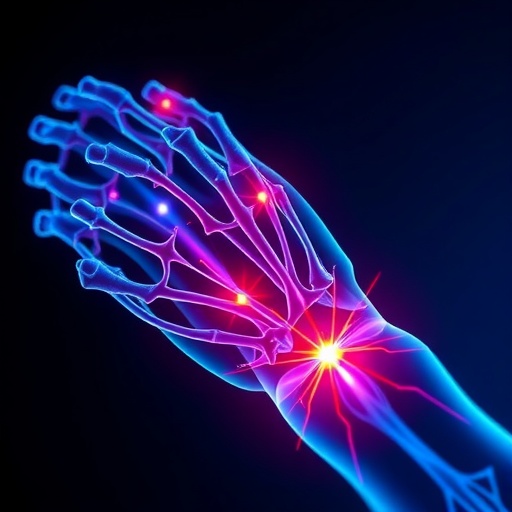In a groundbreaking study published in the esteemed journal Clinical Orthopaedics and Related Research, scientists have unveiled a novel approach to the evaluation of nerve injuries that may significantly enhance surgical decision-making and patient outcomes. This research highlights the efficacy of intraoperative electrical nerve stimulation as a tool to predict recovery potential following acute stretch injuries in rat models, a development that could have profound implications for the field of orthopaedics.
At the core of this research is the premise that not all nerve injuries are created equal. Certain injuries have a higher likelihood of spontaneous recovery while others do not. Traditionally, the evaluation of nerve damage has relied heavily on physical assessments and subjective judgment, leaving surgeons in a challenging position when it comes to determining the necessity for surgical intervention. This study aimed to bridge that gap by investigating the response to electrical stimulation immediately post-injury.
The research team utilized three distinct groups of rat models: a sham-control group, an epineuroclasis group characterized by a milder form of stretch injury known to have favorable recovery potential, and an endoneuroclasis group, which exhibited severe damage likely to result in poor functional recovery. Utilizing a novel neuroclasis model, the researchers were able to induce these precise injury types, thus ensuring a controlled environment for their assessments.
Intraoperative electrical nerve stimulation was performed using a handheld device. The immediate response of each nerve following stimulation was closely monitored and linked to the grip strength of the rats over a 12-week recovery period. The implications of this immediate response were significant; the researchers found a clear correlation between the levels of stimulation and the capacity for recovery.
The results were striking. Out of the 16 nerves assessed in the epineuroclasis injury group, an impressive 15 displayed a positive response to electrical stimulation, indicating a robust potential for recovery. In stark contrast, the endoneuroclasis injury group revealed that only five out of 16 nerves responded, showcasing a dramatically reduced likelihood of recovery. Quantitatively, this data suggests that epineuroclasis injuries are three times more likely to respond to stimulation than their endoneuroclasis counterparts.
Moreover, a retrospective analysis into long-term functional outcomes reinforced these findings, as nerves that failed to respond to stimulation demonstrated a mere eight percent chance of recovering functional capacity. Conversely, the responsive nerves showed a staggering 75 percent probability of recovery, further solidifying the role of electrical stimulation as a predictive tool in clinical settings.
This study stands out not only for its findings but also for its applicability. The use of electrical nerve stimulators is already commonplace in various surgical procedures, providing an opportunity for swift integration of this new diagnostic paradigm into clinical practice. Researchers believe that by adapting existing technologies to assess nerve injuries, they can revolutionize the way practitioners approach acute nerve damage assessment.
The implications of this research extend beyond the laboratory. For patients, accurate assessments of injury severity can lead to tailored treatment plans that spare them unnecessary procedures and potential complications associated with surgical interventions. Improved diagnostic accuracy has the potential to enhance recovery rates, reduce pain, and subsequently improve the overall quality of life for those affected by nerve injuries.
Clinicians could benefit immensely from these findings, as the predictive capabilities surrounding nerve injury assessment can facilitate timely intervention. This is crucial because the window for effective treatment narrows significantly as time progresses post-injury. Understanding whether a nerve is likely to heal on its own or if surgical reconstruction is warranted can ultimately save valuable time and resources while enhancing patient care quality.
While this study focuses on animal models, the research team is optimistic about future validation in human subjects. The integration of real-time evaluation methods during surgery is a pivotal step towards fostering evidence-based practice, potentially reshaping the standard of care for patients sustaining acute nerve injuries in the future.
The excitement surrounding this research has been echoed by lead investigator Dr. Paul J. Cagle, who articulated the significant impact this work could have on orthopedic surgery and its ability to enhance clinical decision-making. The insights gleaned from the study not only aim to push the boundaries of current clinical practices but also signal a transformative era in the management of nerve injuries, with the potential to refine surgical interventions and improve patient outcomes.
Overall, the findings presented in this study represent a significant stride forward in the understanding and management of nerve injuries. By identifying reliable indicators of recovery potential through intraoperative electrical stimulation, clinicians are better equipped to make informed decisions that prioritize patient health and well-being, paving the way for a future where personalized treatment plans become the norm rather than the exception.
As this research progresses, it is anticipated that further studies will delve deeper into the nuances of nerve recovery and the mechanisms underlying these injuries. The eventual goal is to develop comprehensive protocols that encompass both assessment and intervention strategies, allowing for the swift optimization of patient care and outcomes. This work truly embodies the spirit of scientific inquiry and innovation, with the potential to deliver tangible benefits to countless patients grappling with the repercussions of nerve injuries.
In conclusion, the intersection of neurology and surgery is becoming increasingly fruitful as refining tools and methodologies emerge. With the promising findings from this study, the medical community stands on the brink of a significant evolution in the treatment of nerve injuries, heralding a new era of enhanced recovery and improved surgical practices.
Subject of Research: Intraoperative electrical nerve stimulation response and recovery potential in nerve injuries.
Article Title: Is a Response to Intraoperative Electrical Nerve Stimulation Associated with Recovery After Stretch Injury in the Rat Median Nerve?
News Publication Date: October 2023
Web References: Clinical Orthopaedics and Related Research Journal
References: N/A
Image Credits: N/A




